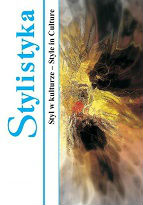ДИСКУРСИВНО-СТИЛИСТИЧЕСКИИ АНАЛИЗ ТЕКСТА
The discourse and stylistic text analysis
Author(s): Elena BazenovaSubject(s): Language and Literature Studies
Published by: Uniwersytet Opolski
Keywords: discourse; text; style; functional stylistics; discourse analyses; scientific text; subtext
Summary/Abstract: The article reviews the correlation between the discourse theory and the theory of functional stylistics. Recognizing the significant contribution of discursive analysis in the study of such a complex phenomenon as text, the author notes that many of the provisions of the discourse theory were successfully implemented in the functional stylistics earlier. In 60th years of XX century professor from Perm-city (Russia) Margarita N. Kozhina developed the methodological basis of functional stylistics, which distinguishes it from “resources stylistics”: speech is determined by extra-linguistic factors which influence on the stylistic and language side of the text. The author considers that de facto subject of study in the functional stylistics was and remains discourse, discourse activity, which is carried out in the main spheres of human life (science, arts, politics, law and others) and expressed in a particular speech organization of the text. Based on the similarity of the most important methodological principles of these linguistic directions, the author suggests these directions should be integrated in the discourse and stylistic approach. This approach is applied to scientific texts. The discourse component of this approach allows identifying extra-linguistic factors of scientific communication; the stylistic component allows discovering the linguistic devices that represent the standard content of a scientific paper. The author develops the concept of epistemic situation and considers the latter to be discourse model of scientific texts, which determines its stylistic peculiarity. The structure of epistemic situation is described with regard to the four interconnected aspects of cognitive activity: ontological, methodological, reflective, communicative-pragmatic. The author reveals the content of each aspect and analyses their influence on the sense structure of a scientific text. The author considers the subtext to be a structural element of the text and describes the primary subtexts: the subtext of a new and old knowledge, the subtext of evaluation, the subtext of recipient and the author, etc. Thus, the discourse and stylistic approach to the text, based on the complementary principles of discourse analysis and functional stylistics, allows identifying patterns of text creation in each communicative sphere, as well as explaining the stylistic diversity of texts. Based on the similarity of the most important methodological principles of these linguistic directions, the author suggests these directions should be integrated in the discourse and stylistic approach. This approach is applied to scientific texts. The discourse component of this approach allows identifying extra-linguistic factors of scientific communication; the stylistic component allows discovering the linguistic devices that represent the standard content of a scientific paper.
Journal: Stylistyka
- Issue Year: 2014
- Issue No: XXIII
- Page Range: 9-18
- Page Count: 9
- Language: Russian

